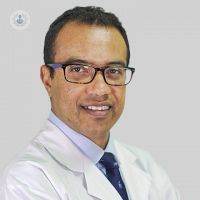What is gynaecomastia?
Written in association with:Gynaecomastia is the enlargement of male breast tissue – gynae- means ‘female’ and -mastia refers to the breasts. Gynaecomastia can range from puffy nipples to enlarged breasts with excess skin. Dr Hassan Nurein, an experienced gynaecomastia surgeon, explains what gynaecomastia is, the causes and how it is treated.

How do you know you have gynecomastia?
Not all cases of enlarged breast tissue are abnormal, however, if it is affecting the appearance under clothing, or if it is affecting your self-confidence, then you are likely suffering from gynaecomastia. In rare cases, you might be experiencing physical symptoms from the enlarged breast tissue, including:
- Discomfort
- Pain
- Discharge
- Stretched skin around the areolas
However, gynaecomastia is very treatable.
What causes gynaecomastia?
Depending on the type of gynaecomastia, each has different causes. True gynaecomastia is caused by an enlarged breast tissue gland, whereas pseudo-gynaecomastia is caused by an accumulation of fat in the breast tissue.
True gynaecomastia (enlarged breast glands) can be caused by physiological reasons or abnormalities, including:
- Congenital defect due to maternal hormone imbalances.
- Abnormalities in hormone levels (male and female hormones) throughout adolescence.
- In older age, men can experience hormone imbalances.
- As a result of another medical condition, such as liver or testicular disease.
- Some prescription drugs can have gynaecomastia as a side-effect.
- A side-effect from using hormones or anabolic steroids – this is increasingly more common in bodybuilder.
- Exposure to industrial chemicals and pesticides to an extent can cause hormonal imbalances which could result in gynaecomastia.
How common is gynaecomastia?
Gynaecomastia is quite a common male condition, and it is thought to affect 1% of the population. In my practice, I have found it to be increasingly more common that the gynaecomastia cases I am treating have been a result of using anabolic steroids or hormones for bodybuilding purposes. I find another common cause of gynaecomastia is weight-gain. It is my belief that there are more men suffering from gynaecomastia than we think.
How is gynaecomastia treated?
Once any serious causes of gynaecomastia have been ruled out, then cosmetic surgery can be carried out to remove the enlarged breast tissue. How we do this depends on the type and grade of gynaecomastia presented. We can either use liposuction to remove excess breast fat, or we can remove the breast gland too. More commonly, we will carry out both liposuction and gland removal. Some patients will also require the removal of excess skin.
When I carry out gynaecomastia surgery, I will use local anaesthetic because it is safer, quicker and means the patient will have less downtime and a quicker recovery. By using local anaesthetic, I am able to have the patient participate in their surgery.
Can gynaecomastia return following gynaecomastia surgery?
If you have had gynaecomastia surgery and a little bit of tissue has been left in place behind the areola, there is a small chance that it may grow back, but this is very rare. Sometimes we leave a little bit of tissue under the areola to prevent the areola from sinking, as in some patients the skin of their areola is weak and underlying tissue is needed to provide support. However, this is rare and in my practice to reassure you, if this happens we try to catch it early and determine whether it is indeed the gland re-growing, or if it is just the scar tissue. If it is the gland, then we can re-operate. This is easier than the initial surgery as it is performed through the original scar at no extra cost.
What is the scarring like from gynaecomastia surgery?
Scarring will depend on the type of surgery you have had. If you have just received liposuction, the incisions are very small (less than 0.5cm) around the areola, the axillary crease and possibly the side as well. These scars will fade over time as well. If the gland is removed as well, then the scars will be around the areola, however, in other practices, these scars could be elsewhere depending on how the surgeon has performed the gland removal. I find that scars around the areolas are less obvious.
Hence, in terms of scarring, this depends on the patient because everyone is different. For most patients, the fact that this has changed their life and the scarring is usually a non-issue and in my practice, most patients don't even notice that they have a scar.
If you are interested in gynaecomastia surgery, make an appointment with Dr Hassan Nurein.



